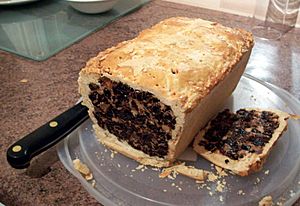Black bun facts for kids

A black bun cut open, showing fruit cake interior
|
|
| Alternative names | Scotch bun, Scotch Christmas bun |
|---|---|
| Type | Fruit cake |
| Place of origin | Scotland |
| Main ingredients | Pastry, raisins, currants, almonds, citrus peel, allspice, ginger, cinnamon and pepper |
The Black bun, also called Scotch bun, is a special kind of fruit cake. What makes it unique is that it's completely wrapped in pastry! It comes from Scotland. Long ago, people ate it on Twelfth Night, but now it's a popular treat for Hogmanay, which is Scotland's New Year's Eve celebration.
This tasty cake usually has raisins, currants, almonds, and citrus peel inside. It's also spiced with allspice, ginger, cinnamon, and even a little black pepper.
What is Black Bun?
Black bun is basically a fruit cake that's covered in a pastry crust. The cake part is similar to a traditional Christmas cake or Christmas pudding. It's full of ingredients like raisins and currants. Plus, it has warm spices such as cinnamon, black pepper, and allspice.
Some people say it looks like a much bigger version of a Garibaldi biscuit. It's even thought that the Garibaldi biscuit might have been inspired by the black bun. This is because its inventor, John Carr, was Scottish!
You can find black bun eaten outside of Scotland too. For example, people in the Appalachia region of the United States enjoy it. In 2013, a famous baker named Paul Hollywood showed how to make it on a Christmas special of The Great British Bake Off.
History of Black Bun
The black bun started as a Scottish King cake. It was eaten on Twelfth Night, which is January 5th. This night is the day before Epiphany and marks the end of the Twelve Days of Christmas.
This tradition came to Scotland after Mary, Queen of Scots returned from France. The custom was to hide a bean inside the cake. Whoever found the bean became the "King" or "Queen" for the evening! It's said that Mary herself played these games. In 1563, her friend Mary Fleming found the bean. Mary, Queen of Scots, dressed her in royal robes and jewels. This surprised the English Ambassador, who wrote about how many jewels Mary Fleming wore that night!
After the Scottish Reformation in 1560, celebrating Christmas was not allowed in Scotland. Because of this, the tradition of using a King cake for Twelfth Night ended.
The black bun we know today became popular in the early 1800s. It was first called "Scotch bun" or "Scotch Christmas bun." The name "black bun" was first written down in 1898.
Black Bun for Hogmanay
Today, black bun is a common part of Hogmanay celebrations. Hogmanay is Scotland's New Year's Eve. A special custom called first-footing happens after midnight on New Year's Eve. People visit their neighbors' homes to celebrate the New Year.
When people go first-footing, they often bring gifts. Giving a black bun was a special gift. It was meant to show that the family receiving it would have enough food and not go hungry in the new year. It was also a traditional cake to serve to guests who visited homes during Hogmanay, often enjoyed with whisky.
See also
 In Spanish: Black bun para niños
In Spanish: Black bun para niños

